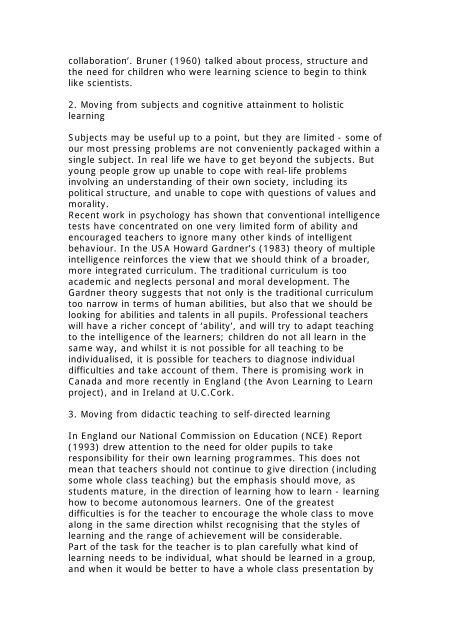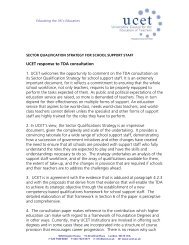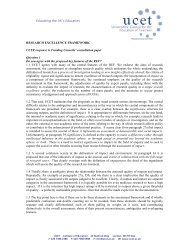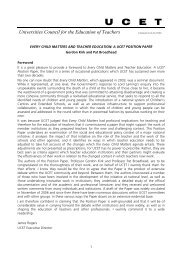The School Curriculum Ten Years Hence - UCET: Universities ...
The School Curriculum Ten Years Hence - UCET: Universities ...
The School Curriculum Ten Years Hence - UCET: Universities ...
You also want an ePaper? Increase the reach of your titles
YUMPU automatically turns print PDFs into web optimized ePapers that Google loves.
collaboration’. Bruner (1960) talked about process, structure and<br />
the need for children who were learning science to begin to think<br />
like scientists.<br />
2. Moving from subjects and cognitive attainment to holistic<br />
learning<br />
Subjects may be useful up to a point, but they are limited - some of<br />
our most pressing problems are not conveniently packaged within a<br />
single subject. In real life we have to get beyond the subjects. But<br />
young people grow up unable to cope with real-life problems<br />
involving an understanding of their own society, including its<br />
political structure, and unable to cope with questions of values and<br />
morality.<br />
Recent work in psychology has shown that conventional intelligence<br />
tests have concentrated on one very limited form of ability and<br />
encouraged teachers to ignore many other kinds of intelligent<br />
behaviour. In the USA Howard Gardner’s (1983) theory of multiple<br />
intelligence reinforces the view that we should think of a broader,<br />
more integrated curriculum. <strong>The</strong> traditional curriculum is too<br />
academic and neglects personal and moral development. <strong>The</strong><br />
Gardner theory suggests that not only is the traditional curriculum<br />
too narrow in terms of human abilities, but also that we should be<br />
looking for abilities and talents in all pupils. Professional teachers<br />
will have a richer concept of ‘ability’, and will try to adapt teaching<br />
to the intelligence of the learners; children do not all learn in the<br />
same way, and whilst it is not possible for all teaching to be<br />
individualised, it is possible for teachers to diagnose individual<br />
difficulties and take account of them. <strong>The</strong>re is promising work in<br />
Canada and more recently in England (the Avon Learning to Learn<br />
project), and in Ireland at U.C.Cork.<br />
3. Moving from didactic teaching to self-directed learning<br />
In England our National Commission on Education (NCE) Report<br />
(1993) drew attention to the need for older pupils to take<br />
responsibility for their own learning programmes. This does not<br />
mean that teachers should not continue to give direction (including<br />
some whole class teaching) but the emphasis should move, as<br />
students mature, in the direction of learning how to learn - learning<br />
how to become autonomous learners. One of the greatest<br />
difficulties is for the teacher to encourage the whole class to move<br />
along in the same direction whilst recognising that the styles of<br />
learning and the range of achievement will be considerable.<br />
Part of the task for the teacher is to plan carefully what kind of<br />
learning needs to be individual, what should be learned in a group,<br />
and when it would be better to have a whole class presentation by






